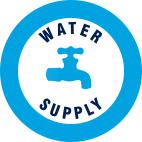
WATER SUPPLY
The construction of a catchment system in rivers, lakes or reservoirs that serve to obtain water and supply it continuously to a community, is a way to guarantee the supply of drinking water after its adequate treatment or for irrigation. In addition, these systems contribute to the control of floods and even surface water overflows.
Water supply systems require a drinking water purification plant where water purification is carried out. The objective of a WWTP is to treat the raw water collected so that it is suitable for human consumption.
Water purification is carried out through a series of chained processes, depending on the characteristics of the water to be treated, and which can be grouped according to their physical-chemical typology:
-
Pre-oxidation: An oxidizing chemical agent is introduced that is capable of removing any matter that can be oxidized, both organic and inorganic.
-
Coagulation and flocculation: Grouping of the particles responsible for the color and turbidity of water.
-
Decantation: Through the action of gravity, the particles of the previous process are deposited at the bottom, forming a sludge or sludge that is extracted to be treated later.
-
Filtration: Process of retention of particles that could not be extracted in the previous process by passing the water through filters.
-
Neutralization: The acidity of the water is adjusted by chemical reagents.
-
Final disinfection: Other reagents, usually chlorine and ammonia, are added to eliminate microorganisms that may have survived the previous processes and guarantee the quality of the water throughout the distribution network.
The water collection system is one of the most important points to ensure the continuous supply of drinking water. Microtunnels are a versatile solution for any type of water collection regardless of the geological, hydrological and topographic characteristics of the area.

The construction of the water collection system is based on a catchment chamber, the underwater outfall by microtunnel that connects to a water intake tower. This solution minimizes the environmental impact in the area of action due to its low impact on environments and the great flexibility they provide in terms of design.
Bibliography:
-
Peter Hennig y Lutz zur Linde, (18/May/2011). Trenchless installation methods of Sea Outfalls. OSMGP.
osmgp.gov.ar/symposium2011/Papers/50-henning.pdf
-
CEYRANBATAN UF PLANT PROJECT. Bringing drinking water to Baku
eurohinca.com/pdf/fichas-obra/2014.05-publicacion-az-mayo-2.pdf
-
Sea water intake. Microtunel.
microtunel.com/aplicaciones-sumergidas
-
Roberti Pérez, Luis. Catchment of rivers, lakes and reservoirs (reservoirs)
sswm.info/es/gass-perspective-es/tecnologias-de/tecnologias-de-abastecimiento-de-agua/captacion/captaci%C3%B3n-de-r%C3%ADos%2C-lagos-y-embalses-%28reservorios%29
-
DWTP.
https://www.iagua.es/respuestas/que-es-etap
-
Drinking water treatment plant.
https://www.canaldeisabelsegunda.es/-/asi-funciona-una-estacion-de-tratamiento-de-agua-potable


